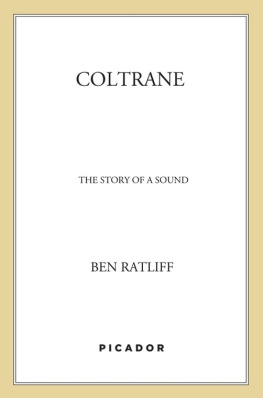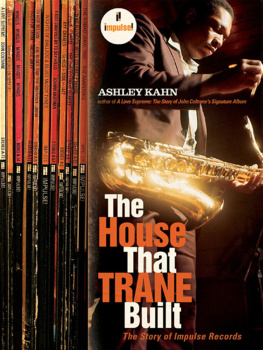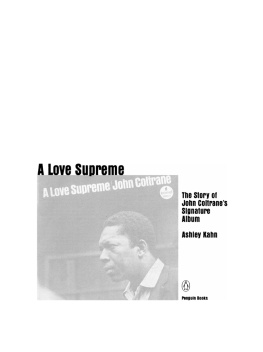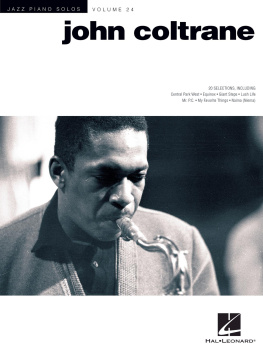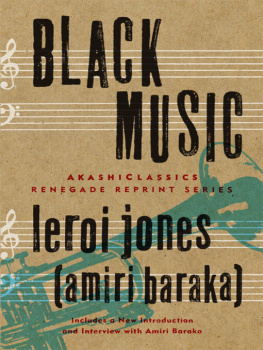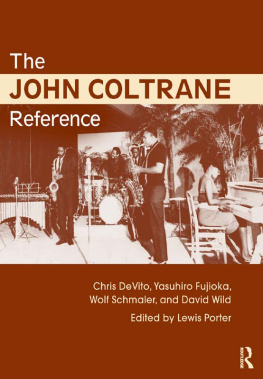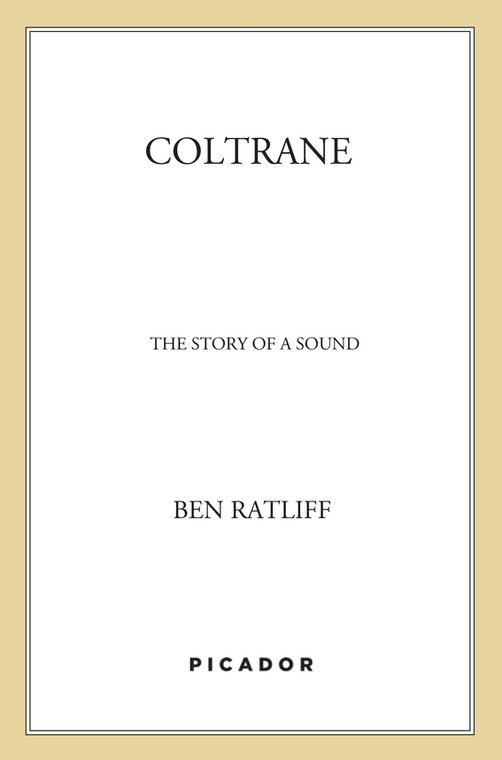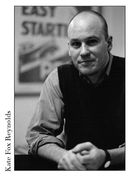4 John just sat there, taking it all in: J. C. Thomas, Chasin the Trane, p. 36.
6 I used to practice a lot with Trane: Jimmy Heath, interview with author.
7 We were extracting the cadenzas: Jimmy Heath, interview with Howard Mandel for documentary film The World According to John Coltrane , early 1980s.
7 Whos Willie Mays, Jim?: Jimmy Heath, interview with author.
8 Johnny Griffin saw that band: Johnny Griffin, interview with Jim Standifer, October 30, 1982, oral-history interview from University of Michigan African-American Music Collection.
9 Yeah, little ol Coltrane: Coltrane, interview with Gardner.
12 peculiar hypnotic pattern not met with before: from Steven Watson, Prepare for Saints: Gertrude Stein, Virgil Thomson, and the Mainstreaming of American Modernism (New York: Random House, 1998), p. 42.
12 What I didnt know with Diz: Coltrane, interview with Gitler.
13 I found that by using: Nat Shapiro and Nat Hentoff, Hear Me Talkin to Ya (New York: Dover, 1966), p. 354.
14 Von Freeman, the tenor saxophonist: Von Freeman, interview with Ted Panken, WKCR, June 17, 1987.
16 In a landmark sociological study: Charles Winick, The Use of Drugs by Jazz Musicians, Social Problems 7, 1959.
17 Briefly in 1952 he played with Gay Crosse: Coltrane is known to have played with Gay Crosse and possibly recorded with him. Lewis Porter suggested that Coltrane was the airy-toned alto soloist on Bittersweet, a ballad recorded by Gay Crosse & The Good Humor Six in 1952. In the capacity of researcher and adviser, he passed on the track to Atlantic Records for its Coltrane box set The Last Giant in 1993, and suggested in his 1998 biography that among the Crosse recordings it was a likely candidate as a Coltrane item. He has since changed his mind, on the grounds that it just doesnt sound convincingly like Coltrane on alto.
19 a style that had no name: Benny Golson, interview with author.
19 I really enjoyed that job: Coltrane, interview with DeMichael, Coltrane on Coltrane.
19 those chords screaming at me: Coltrane, interview with Blume.
20 Columbia Records signed Davis: George Avakian, interview with author.
23 The Prestige sessions proceeded without rehearsal: Ira Gitler, interview with author.
25 A bassist of Paul Chamberss stature: Coltrane, interview with Postif (translation mine).
25 Ive always been struck: Red Garland quoted in Nat Hentoffs liner notes to Garlands Soul Junction (Prestige/Fantasy).
26 He said, How are you?: David Amram, interview with author.
28 Miles eventually cursed Trane out: John Gilmore quoted in Robert Palmer, Exploring the Jazz Legacy of John Coltrane, New York Times , September 29, 1974.
30 Coltrane told Rollins that he wanted to record with him again: Sonny Rollins, interview with author.
31 Sonny Rollins, you heard him recently?: Coltrane, interview with Blume.
31 He believed in jam-session recordings: Ira Gitler, interview with author.
32 There is too much echo on the soloists: Bill Coss, Metronome , July 1956.
34 The contract, dated April 9, 1957: Contract was reproduced in the auction catalogue for Guernseys Jazz Auction, held February 20, 2005, at Rose Theater in New York City.
34 An article came out in a Cleveland newspaper: From Simpkins, p. 83.
34 He later made reference to drinking late-night scotches: Coltrane, interview with Postif.
36 Monk was just another iron in the fire for John: Benny Golson, interview with author.
36 I always had to be alert with Monk: Joe Goldberg, Jazz Masters of the Fifties , p. 199.
37 letting the band play for twenty minutes at a time: Coltrane, interview with Postif.
40 Orrin Keepnews, who ran Riverside: Peter Keepnews, e-mail to author, December 2005.
42 I was trying for a sweeping sound: Coltrane, interview with DeMichael, Coltrane on Coltrane.
42 I thought in groups of notes, not one note at a time: Ibid.
42 I was beginning to apply: Ibid.
43 I got interested in [the harp] around 1958: Coltrane, interview with Wilmer.
43 due to the direct and free-flowing lines: DeMichael, Coltrane on Coltrane.
45 Russell had already talked with Miles about modes: Kahn, Kind of Blue, p. 69.
46 When you go this way, you can go on forever: Nat Hentoff, An Afternoon with Miles Davis, The Jazz Review , December 1958, pp. 1112.
47 making substitutions on my substitutions: George Russell, interview with Ashley Kahn, in Kind of Blue, p. 69.
48 In a review of the Newport concert: Don Gold, review of Miles Davis Sextet at Newport Jazz Festival, Down Beat , August 7, 1958.
48 at home Coltrane was listening hard to contemporary symphonic music: Zita Carno, interview with author.
48 Coltrane was thirty-two: Wayne Shorter, interview with author.
48 Coltrane had already told a journalist: Oakland Tribune, June 14, 1959, quoted in Simpkins, p. 90.
49 The way Miles used these modes: George Russell, interview for Tell Me How Long Tranes Been Gone.
49 Davis revealed two extramusical inspirations: Davis and Troupe, p. 234.
52 Tommy Flanagan, the pianist on Giant Steps: Porter, p. 155.
53 Giant Steps, everything I did on that: Coltrane, interview with Grant.
55 He didnt really want to make the gig: Thomas, pp. 108109.
58 I have never tired of his complex playing: Bobby Jaspar, Elvin Jones and Philly Joe Jones, The Jazz Review , February 1959.
58 including, Tyner remembers, the Giant Steps changes: McCoy Tyner, interview with author.
58 Steve Kuhn, the pianist he worked with: Porter, p. 176.
58 he himself has used the word metronomic: McCoy Tyner, interview with Franois Postif, quoted in Porter, p. 178.
58 He told the French critic Franois Postif: Coltrane to Postif, John Coltrane: Une Interview, Jazz Hot , January 1962.
61 one need not be within earshot: Scott, p. 116.
61 closely resembled the music of primitive savages: Scott, p. 142.
62 If you repeat: flower, flower, flower: Khan, p. 21. The writer Eric Nisenson has said that Sonny Rollins thought he remembered Coltrane recommending Hazrat Inayat Khans book to him.
62 Unlike Cyril Scott, Khan had no problem with jazz: Khan, p. 51.
62 I dunno, I may be wrong on this: Coltrane, from Tokyo Prince Hotel press conference, 1966.
63 The playbacks havent sounded right: Coltrane to Wilmer.
64 In 1960, during a stint: Roy Haynes, interview with author.
64 He asked Paul Motian in 1965: Paul Motian, interview with author.
64 The person with whom I would have the most pleasure: Coltrane to Postif.
64 When [Ornette] came along: Coltrane to Benot Quersin, Jazz , January 1963.
65 Heres how I play: Coltrane to Postif.
66 My real pianist: Ibid.
68 Roy Haynes remembers going by Dolphys house: Roy Haynes, interview with author.

